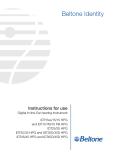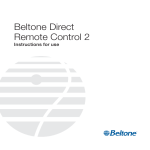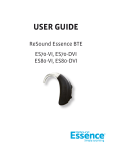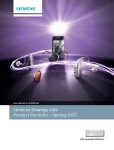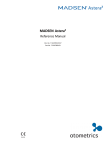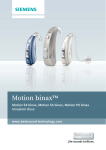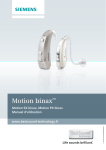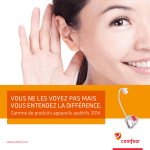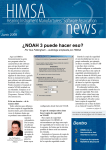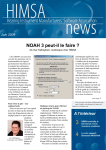Download Beltone IDT76D Specifications
Transcript
Beltone Identity Instructions for use Digital Behind-the-Ear hearing instrument IDT66D and IDT66D Open IDT76D and IDT76D Open IDT86D A new Beltone hearing instrument Congratulations on your choice of a Beltone hearing instrument! This is an important step towards clearer hearing and better understanding. We have used all our experience with hearing instruments to help you communicate, lead an enjoyable social life and listen to the world around you. Your hearing instrument is a very advanced device. Your hearing care practitioner has tuned it to your individual needs. With a little devotion and patience you will become familiar with it. This booklet is a short guide to assist you in getting acquainted with your hearing instrument. Read it carefully and use it as a guideline. We wish you happiness and pleasant listening with your new instrument. Beltone 2 This booklet & your instrument In this booklet you will find instructions for inserting and controlling your new hearing instrument. You will find explanations on controlling your instrument, on daily handling and on its use. Furthermore, you can read what to do if things do not live up to your expectations. We will give a few practical steps towards better hearing. Contents Your Hearing Instrument Switching on and off Changing batteries Inserting and removing the instrument Setting the volume Program button Dual microphone system T-program Audio input Maintenance and cleaning General warnings Eight steps towards better hearing General precautions Technical specifications Solving small problems International warranty Your selected model 4-6 8 9 11 16 17 18 19 21 22 26 27 31 33 34 36 37 3 Your Hearing Instrument Tone tube Microphone Microphone behind cover Program button Plastic tube Battery door Earmold Mini BTE Hearing Instrument ThinTube Microphone Microphone behind cover Program button Battery door Mini dome 4 Mini BTE Hearing Instrument with ThinTube Tone tube Microphone Microphone behind cover Program button Plastic tube Volume toggle Battery door Earmold BTE Hearing Instrument Microphone Microphone behind cover ThinTube Program button Volume toggle Mini dome BTE Hearing Instrument With ThinTube Battery door 5 Tone tube Microphone Microphone behind cover Program button Plastic tube Volume toggle Battery door Earmold Power BTE Hearing Instrument 6 7 Switching on and off Your instrument is equipped with an on/off switch integrated into the battery compartment. When the battery compartment is fully closed, the instrument is turned on. To turn the instrument off grasp the battery compartment door with your fingernail and gently pull downwards. The power will switch off at switch off the instrument the point where you can feel a small click. After switching on the device, the volume will be as set by your hearing care practitioner. Read more on this subject on page 16. Your instrument has a push button to switch programs. If you close the battery door your instrument will always start in program number 1. Read more on this subject on page 17. • Switch your instrument off if you are not using it. This will increase the battery life. • At night, switch off your instrument and open the battery door completely. It allows moisture in your instrument to evaporate and will increase the instrument’s life span. 8 Changing batteries When the battery voltage/power decreases to a certain level, the instrument will emit a soft beeping signal. This signal will continue for about one minute, and the sequence will continue every five minutes until the instrument will be automatically switched off. It is therefore advisable to keep an extra battery at hand. open battery door completely Open the battery compartment completely by using your fingernail. The end of the cleaning brush is magnetic. Use this for easy battery removal and insertion. The replacement battery has to be a zinc-air battery or an appropriate Nickel Metal Hydride rechargeable battery. Size depends on your instrument: Instrument type Battery size Mini-BTE 312 BTE 13 Power BTE 13 exchange battery Remove the protective seal from the fresh battery and insert it in the battery door. Check that the + symbols on the battery and on the battery door are on the same side. Always insert a battery in the opened door, never directly into the instrument. Close the battery door. This should go smoothly, so never force it as this could damage your instrument. 9 Warnings • Keep batteries away from children and mentally challenged persons. • Batteries can be harmful if swallowed. If you do, seek medical attention immediately. • Do not attempt to recharge batteries (Zinc Air) which are not specifically designated rechargeable as they may leak or explode. • Do not burn the batteries, as they could explode. • Replace spent batteries and do not leave them in the instrument for a prolonged period. • Used batteries are harmful to the environment. Please dispose of them according to local regulations or return them to your hearing care practitioner. 10 Inserting and removing the instrument (standard earmould) Inserting the instrument • With the battery door opened in the off position take the earmould between thumb and index finger and position its ‘point’ in your ear canal. Now, slide the earmould all the way into your ear with a gentle, twisting movement. Insertion can be easier if you gently pull your auricle backwards with your other hand. • Turn the top-part of the earmould gently backwards and forwards so that it fits behind the fold of skin above your ear canal. • Place the hearing instrument behind your ear. Move the earmould up and down and press gently to ensure it is positioned correctly in the ear. Opening and closing your mouth can ease insertion. You will feel when the earmould is positioned correctly. • When correctly positioned switch on your instrument by closing the battery door. 11 • You can as well insert the hearing instrument while in the on position. However you might experience some feedback (whistling) during the operation. Removing your instrument • Switch off the instrument by shifting the battery door to the ‘off’ position. • Lift the hearing instrument from behind the ear. For a moment, let it hang beside your ear. • Using your thumb and index finger, gently pull the earmould (not the instrument or the tubing) loose from the ear. • Remove the earmould completely by gently twisting it. 12 Inserting and removing the instrument (ThinTube) Inserting the instrument • Hang the instrument over the top of the ear. • Grasp the sound tube where it bends. The dome should be placed far enough into the ear that the sound tube lies flush with your head. When the dome is placed appropriately, you should not see the sound tube sticking out when you look directly into a mirror. • If the device whistles, the most likely reason is that the dome is not placed correctly in the ear canal. Other reasons can be buildup of earwax in the ear canal, or that the sound tube connection to the instrument has become loose, in which case the sound tube must be changed. It is also possible that the instrument settings are not optimal. If you have ruled out other reasons for the instrument squealing, it is recommended to contact your hearing care professional. 13 Recognising left and right instrument If you have two hearing instruments, they may be tuned differently. One for your left ear, the other for your right. Do not swap them. Please pay attention to this when cleaning, storing and inserting the instruments. 14 left right left right • You might want to ask your hearing care practitioner to mark your instruments with a coloured Left and Right indication: Left is blue and Right is red. indication side indication 15 Setting the volume – BTE and Power BTE Your instrument has a fully automatic volume control. Therefore, it should not be necessary to control the amplification (volume) manually. However, the volume control toggle provides you with the ability to adjust the amplification to your liking. Use your index finger to adjust the volume, pushing the toggle horizont ally or upwards to increase and downwards to decrease the volume. During the fitting of the instrument, your hearing care practitioner will have chosen an optimal volume setting for you. When switching the instrument on, the volume will have this optimal setting. • To prevent unintended usage by paediatric or physically or mentally challenged users, the volume control must, if enabled, be configured to only provide a decrease of the sound generator output level. • If you prefer not to use the volume toggle your hearing care practitioner can switch the volume control off and even physically remove it and replace it with a lid. 16 Program button Your hearing instrument has a program button allowing you to use up to four different listening programs, each of them suitable for certain situations. After pressing the program button, the instrument will switch program. If it was in program 1 it will switch to program 2, if it was in program 2 it will switch to program 3 etc. If program 2, 3 or 4 are not activated, nothing will happen. Your instrument will give an audible signal after pressing the program button. A little later, the instrument will give: • one single beep if set in program 1 • two beeps if set in program 2 • three beeps if set in program 3 • four beeps if set in program 4 When you close the battery door and switch the instrument on it will start in program 1, confirmed by one single beep. Press the program button if you want to move to a different listening program. 17 Let your hearing care practitioner fill out the following table: Program number Type of program Intended for 1 2 3 4 Dual microphone system If you want to listen to a person in a noisy environment, the micro phones in your hearing instrument can help you to concentrate on the speech. If the microphones are in the directional mode the background noise will be attenuated. In this mode the sounds in front of you will be enhanced, so you can hear better the speech of the person you look at. Your hearing care practitioner can program the device in the required modes. Depending on your hearing instrument and the setting chosen by you and your hearing care practioner switching to and from directional mode can be done automatically. 18 T-program Your hearing instrument has a built in function, the telecoil, enabling in many cases an improved use of the telephone and better hearing in those churches or halls where an induction loop system is installed. In order to activate this function, the telecoil program has to be selected (often available in program 2). In this program you will hear no sounds from the microphone, therefore most environmental sounds will be lost. If you wish, your hearing care practitioner can change the setting in such a way that you hear the microphone and the telecoil simultaneously. Using the telephone. • Switch your instrument to the telecoil program. • Hold your telephone handset behind your ear, close to the hearing instrument (2-3 cm.) and slightly tilt the receiver outwards. • Listen to the dialing tone and move the handset a little to find the position that gives the best reception. • If needed, turn the volume up or down. • After completing the phone call, switch your instrument back to the microphone program. If the phone used has poor telecoil signal, use the microphone program. Do not hold the handset too tightly against your ear since this might cause ’whistling’. 19 Hearing through an induction loop More and more public places, churches, theatres and cinemas, have induction loops systems. In these particular rooms, they transmit, wirelessly, the sound of the presenter or show. At home, radio or television can be connected to an induction loop system. Sound quality through induction loop is often better because noises from the environment are not transmitted. • Switch your instrument to the telecoil program. • Choose a good spot. Reception is not clear in all locations; it depends on the position of the induction loop. Watch for signs or try a different seat yourself. • If needed, adjust the volume up or down. • After the service or show, switch your instrument back to the microphone program. You will now hear through the microphone again. • If the sound of your hearing instrument in the telecoil program is very soft all the time, ask your hearing care practitioner to make an adjustment. • Your hearing care practitioner will gladly provide you with advice regarding an induction loop system at home. Ask for it. 20 Audio input Your hearing instrument is equipped with a direct audio input facility. Direct audio input allows direct connection of sound sources, a radio, television or even school equipment, to your hearing instrument. Often, this will improve sound quality. • The sound source is connected to your instrument with a cable and an audio shoe. • The instrument automatically detects the direct audio input source. The direct audio input supports the systems for the wireless use as well. • In this program you will hear no sounds from the microphone, therefore most environmental sounds will be lost. If you wish, your hearing care practitioner can change the setting in such a way that you hear the microphone and the direct audio input simultaneously. Safety regulations External equipment, connected to the mains and to the audio input must comply with these safety regulations: IEC-65, IEC-601 or comparable. 21 Maintenance and cleaning Earwax (cerumen) can accumulate in and on the earmould during use. Therefore, clean your earmould regularly. Failure to do so can lead to an accumulation of earwax, impairing sound quality. Keep your hearing instrument clean and dry. Wipe the case with a soft cloth or tissue after use to remove grease or moisture. You should avoid exposing your instrument directly to moisture such as rain or water from the shower. If your instrument does get wet or if it has been exposed to high humidity or perspiration, it should be left to dry out overnight with the battery out and the battery compartment open. It is also a good idea to put them in a sealed container together with a drying agent (dessicator) overnight. Consult your hearing care professional as to which drying agent to use. Storing your instrument When you are not using your instrument, keep or transport it in the box supplied. Leave the battery door open. Keep your instrument in a dry place, not in a bathroom or other humid place. Alternatively, you could store the instrument in a dessicator available from your hearing care practitioner. 22 Cleaning the earmold • First, remove the tubing and earmold from the hearing instrument. Keep left and right instrument separated. • Remove earwax with the cleaning brush and a soft cloth. If needed, use a mild solution of soft soap and water or a special cleaning solution. Ask your hearing care practitioner for detailed instructions. pull earmold and device apart • Rinse the earmold with water. Note: Do not use water or other liquid on the hearing instrument itself. 23 • Dry the earmold with a cloth. • Let the earmold dry overnight on a tissue or blow possible water drops from tubing and earmold. A special device is available for this from your hearing care practitioner. • Ensure that the earmold and tubing are completely dry before attaching them to the hearing instrument. Take care with left and right instruments, check the figures on page 14. Replacing the tube Ask your hearing care practitioner to replace the tubing from the instrument to the earmould if it turns stiff or changes colour. Cleaning the ThinTube and dome The ThinTube The ThinTube feeds the amplified sound from the hearing instrument into the ear. It is important that the ThinTube and the dome fit correctly into your ear. If the ThinTube or the dome irritate your ear in any way and prevent you from wearing your hearing instrument, please contact your hearing care professional. You should never attempt to modify the shape of the ThinTube yourself. 24 The ThinTube and the dome should be cleaned regularly. Remove the ThinTube from the instrument before cleaning by unscrewing it. Use a damp cloth to clean the ThinTube and dome on the outside and use the black cleaning rod to “push” any debris out of the sound tube. The cleaning rod should be inserted where the ThinTube attaches to the instrument and pushed all the way through the ThinTube and out through the dome. It is not recommended to submerge or rinse the ThinTube and dome with water, as there is a risk that a water drop may become lodged in the ThinTube. If this should occur, it will prevent sound coming through the ThinTube, and may be harmful for the instrument’s electronics. The ThinTube and dome should be changed every third month or sooner if the ThinTube becomes stiff or brittle. We recommend that you have your hearing care professional change the dome for you. If your hearing care professional instructs you to change the domes yourself, make sure that they are securely fastened to the ThinTube before inserting them in your ear. A failure to change the domes in accordance with the instructions could result in injury. 25 General warnings Hearing instruments can be dangerous if improperly used. • Do not leave your instrument in the sun, near an open fire or in a hot, parked car. • Do not wear your instrument while showering, swimming, in heavy rain or in a moist atmosphere such as steam bath or sauna. • Should your instrument become moist, put it in a dessicator. Your hearing care professional will be happy to counsel on this. • Remove your instrument when applying cosmetics, e.g. perfume, aftershave, hair spray, suntan lotion. • Instruments should be used only as prescribed by your hearing care professional. Incorrect use may result in sudden and permanent hearing loss. • Do not allow others to use your instrument. It may cause permanent damage. • Instrument usage by children or mentally challenged persons should be supervised at any time. • Do not take your instrument into rooms where you receive treatment with X-rays or MRI. • Wearing an instrument might cause an increased production of earwax. In rare cases, the anti-allergenic materials may cause skin irritation. If so, or if in doubt, consult your physician or ENT. 26 Eight steps towards better hearing You need to get used to your new hearing instrument. Sounds seem new and different. That is because you grew accustomed to your diminished hearing. Therefore, familiar sounds seem strange or unnatural at first. Every first-time user of a hearing instrument responds differently to this. Some can wear the new instrument a whole day right from the start while others find it hard to get used to. After a while, you will notice you appreciate hearing with a hearing instrument and that you will find it quite normal. Below, eight steps are described that will guide you through the initial period. If you are not satisfied or keep experiencing problems, please consult your hearing care practitioner. 1. Get used to familiar sounds at home Try to get used to the new sounds from a familiar environment. Listen to the different (background) sounds and try to recognise them. When you are tired from listening, remove your instrument and pause for a while. Talk or read aloud for a while. In that way you will familiarise yourself with the sound of your own voice. Gradually, you will learn to use the instrument for longer and become more comfortable with it. 2. Listen outside - quiet & traffic Go outside, to a quiet place, e.g., the park or woods. Listen to the environmental sounds. Do you recognise them? Please, be careful with sounds from heavy traffic at this stage of getting used to your instrument. Sometimes they sound very loud; try not to get frightened. 27 3. Have a conversation with a single person Use your instrument in conversation with one person; a family member or a friend. Move to a quiet spot. Explain that you are now wearing a hearing instrument; ask the other person to talk normally. Look at your conversation partner. If your instrument is tuned to your requirements you will be able to communicate better than before. 4. Listen to radio or television Listen to the radio or television. Start with the news, then turn to another program. Ask a ‘normal hearing’ person to set the volume of your radio or television to a comfortable level. If necessary, adjust the volume on your hearing instrument. If you cannot understand the radio or television, ask your hearing care practitioner to adjust your hearing instrument. He or she is able to inform you on other facilities such as an induction loop at home for radio or television. 5. Get used to conversation in a group Following conversations in a group is often difficult because of the background noise. Listen to the different voices. Try to recognise them by timbre or rhythm and link each voice to a person. Focus your attention on the person you want to understand. Practice this regularly. If you did not understand something that was said, please ask for it to be repeated. Ensure that you can see the face of your conversation partner(s) clearly and that there is sufficient light. This will help you to lipread. Avoid ‘looking into the light,’ position yourself with your back towards the window so that you can see the other person(s) better. 28 Ask others to talk slowly and clearly. Talking louder does not help. If your instrument is equipped with a Dual Microphone System, select the directional listening program. Read more on this on page 16. 6. Visit public buildings Visit public buildings. Try to sit near the speaker; try to be seated in the front rows in a show. Avoid a seat behind a pillar or in an alcove, you will be in a ‘sound shadow.’ In a restaurant, sit with your back towards the wall. This avoids disturbing noises coming from behind you. Some public buildings have an inductive loop system. In these buildings use your telecoil program, if activated. However, not every position in the building will have good sound reception. Watch for signs at the location or try a different seat. 7. Use your telephone Often, you can hear the telephone clearly with your hearing instrument in the microphone program. Hold the telephone handset 1 inch (2-3cm) from your ear and tilt the receiver outwards a little. See whether or not the telephone sounds better if you switch your hearing instrument to the telecoil program. Read about this on page 19. Your hearing instrument meets strict international regulations. Therefore, it should be possible to use a GSM telephone in most cases. However, in some circumstances, disturbance might be audible through your hearing instrument. 29 8. Use your instrument all day Using your hearing instrument and practising with it is the best way to learn to hear again. Even if you can hear without an instrument in some cases. Try to wear your instrument all day. In that way you will benefit the most. Of course, a hearing instrument cannot restore natural hearing, but it will help you make the most of your hearing as it is today. Go beyond these eight steps and discover the world of sound around you. Do the things you enjoy and listen to the sounds from your environment. 30 General precautions • Consult a physician if you find a foreign object in your ear canal, if you experience skin irritation or if excessive ear wax accumulates with the use of the instrument. • Different types of radiation, e.g. from NMR or CT scanners, may damage the instrument. Therefore, do not wear the instrument during these or other corresponding scanning procedures. Other types of radiation (burglary alarms, room surveillance systems, radio equipment, mobile telephones, etc) will not damage the instrument. They could, however, momentarily affect the sound quality or create strange sounds from the instruments. • Warning: Do not wear the instrument in mines or other explosive areas, unless those areas are certified for hearing instrument use. • Keep the instrument away from children under the age of 3 as it contains small parts which may present a choking hazard. Warning to hearing care practitioners Special care should be exercised in selecting and fitting a hearing instrument(s) whose maximum sound pressure level exceeds 132 dB SPL with an IEC 60711: 1981 occluded ear simulator, because there may be a risk of impairing the remaining hearing of the hearing instrument user. 31 Technical specifications Audio signal technology Digital Hearing instrument maximum output (IEC 118-0 OES) model IDT66D 131 dB SPL IDT66D Open 127 dB SPL IDT76D 133 dB SPL IDT76D Open 132 dB SPL IDT86D 140 dB SPL 32 33 TROUBLESHOOTING GUIDE Symptom Feedback, ’whistling’ cause Is your earmould/Dome inserted correctly? Is the volume very loud? Is the plastic tube or the earmould clogged or broken? Are you holding your hand or an object (e.g. a hat) too close to an instrument? Is you ear full of wax? No sound Is the instrument switched on? Is the instrument switched on the telecoil program? Is there a battery in the instrument? Is the battery still good? Is the plastic tube or the earmould clogged or broken? Is you ear full of wax? Sound is distorted, spluttering or weak Is the battery dead? Is the battery dirty? Is the plastic tube or the earmold clogged or broken? Did your instrument get moist? Battery drains very quickly 34 Did you leave your hearing instrument switched on at night? Is the battery old? POSSIBLE REMEDY Put it in again Reduce it Visit your hearing care practitioner Move your hand away or create some more space between the instrument and the object Visit your physician Switch it on Switch it to the microphone program Insert a battery Replace it with a new one Visit your hearing care practitioner Visit your physician Replace it with a new one Clean it or use a new one Visit your hearing care practitioner Use a dissecator Always switch off the instrument at night Check the date on the battery packaging 35 International warranty and service Any digital hearing instrument from Beltone has an international warranty. Read more on this subject on the warranty card you received with your instrument. Repairs If your Beltone hearing instrument malfunctions, it must be repaired by a qualified technician. Do not attempt to open the case of the hearing instrument since this would invalidate the warranty. If your Beltone hearing instrument requires service, please contact your hearing care professional for assistance. 36 Your selected model Your hearing care professional place a check mark in the below table to identify the model you have received. Model received Hearing care professional IDT66D Mini BTE IDT66D Open Mini BTE IDT76D BTE IDT76D Open BTE IDT86D Power BTE Serial number Right: Serial number Left: 37 38 39 Any issues relating to the EU Medical Device Directive 93/42/EEC should be directed to Beltone A/S, Denmark 16897300 GB-08.06 Rev. A Printed in Denmark © Beltone 2008 Beltone A/S Lautrupbjerg 9 DK-2750 Ballerup Denmark Tel.: +45 45 75 11 11 Fax: +45 45 75 11 19









































